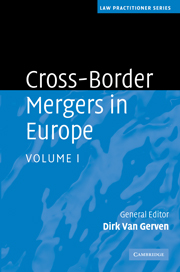Book contents
- Frontmatter
- Contents
- Contributors
- Preface
- Part I EC rules on cross-border mergers
- Part II Application in each Member State National reports for the EU Member States
- 5 Austria
- 6 Belgium
- 7 Bulgaria
- 8 Cyprus
- 9 Czech Republic
- 10 Denmark
- 11 Estonia
- 12 Germany
- 13 Hungary
- 14 The Netherlands
- 15 Poland
- 16 Slovak Republic
- 17 United Kingdom
- Part III Application in the EEA Member States
- Part IV Annexes
- Index
5 - Austria
from Part II - Application in each Member State National reports for the EU Member States
Published online by Cambridge University Press: 03 May 2010
- Frontmatter
- Contents
- Contributors
- Preface
- Part I EC rules on cross-border mergers
- Part II Application in each Member State National reports for the EU Member States
- 5 Austria
- 6 Belgium
- 7 Bulgaria
- 8 Cyprus
- 9 Czech Republic
- 10 Denmark
- 11 Estonia
- 12 Germany
- 13 Hungary
- 14 The Netherlands
- 15 Poland
- 16 Slovak Republic
- 17 United Kingdom
- Part III Application in the EEA Member States
- Part IV Annexes
- Index
Summary
Introduction
1. The Cross-border Merger Directive has been implemented in Austria by the Corporate Law Amendment Act 2007 (Gesellschaftsrechts-Änderungsgesetz 2007). This Act has introduced the EU Merger Act (EU-Verschmelzungsgesetz, short name: EU-VerschG) – a new Act which supplements the provisions on domestic mergers provided for in the Limited Liability Companies Act (Gesetz über Gesellschaften mit beschränkter Haftung, short name: GmbH-Gesetz) and the Stock Corporation Act (Aktiengesetz). The EU Merger Act provides that the provisions applicable to domestic mergers shall apply also to crossborder mergers unless provided for otherwise in the EU Merger Act. Therefore, basically the Stock Corporation Act, the Limited Liability Companies Act (in case a limited liability company is involved) and the EU Merger Act form the Austrian statutory framework applicable to cross-border mergers.
The EU Merger Act became effective on 15 December 2007; Austria therefore has met the deadline for transposition provided for in Article 19 of the Cross-border Merger Directive.
Scope of the new rules
2. The EU Merger Act applies expressly to Austrian stock corporations (Aktiengesellschaften) and Austrian limited liability companies (Gesellschaften mit beschränkter Haftung). Although not expressly provided for by the EU Merger Act, the new rules on cross-border mergers also apply to existing European companies (SEs). The EU Merger Act does not apply to the formation of a (new) SE by means of a merger (see Chapter 1, no 9 of this book).
- Type
- Chapter
- Information
- Cross-Border Mergers in Europe , pp. 81 - 103Publisher: Cambridge University PressPrint publication year: 2010
- 1
- Cited by



